
The Pieridae are a large family of butterflies with about 76 genera containing about 1,100 species, mostly from tropical Africa and tropical Asia with some varieties in the more northern regions of North America and Eurasia. Most pierid butterflies are white, yellow, or orange in coloration, often with black spots. The pigments that give the distinct coloring to these butterflies are derived from waste products in the body and are a characteristic of this family. The family was created by William John Swainson in 1820.

Euchloe lucilla, the lemon white, is a small butterfly of the family Pieridae, the yellows and whites. The butterfly is found in India.

Aporia leucodice, the Himalayan blackvein, is a mid-sized to large butterfly of the family Pieridae, that is, the yellows and whites, which is found in India.
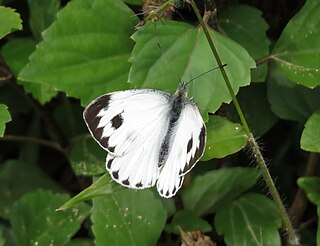
Pieris canidia, the Indian cabbage white, is a butterfly in the family Pieridae found in India, Nepal and Indochina. Pieris rapae is one of the most closely related species in the Pieridae.
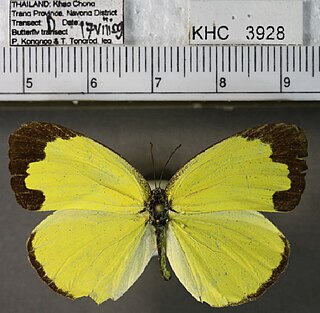
Eurema lacteola, the scarce grass yellow, is a small butterfly of the family Pieridae, that is, the yellows and whites, which is found in India, Peninsular Malaya, Java, Sumatra and Borneo.

Eurema andersonii, the one-spot grass yellow or Anderson's grass yellow, is a small butterfly of the family Pieridae, that is, the yellows and whites, which is found in India, Myanmar and other parts of Asia.
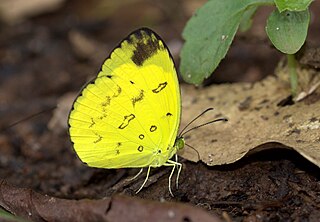
Eurema nilgiriensis, the Nilgiri grass yellow, is a small butterfly of the family Pieridae, that is, the yellows and whites, which is found in south India.

Dercas verhuelli, the tailed sulphur, is a small butterfly of the family Pieridae, that is, the yellows and whites, which is found in India, Burma, China, Peninsular Malaya and Indochina.

Gonepteryx mahaguru, the lesser brimstone, is a medium-sized butterfly of the family Pieridae, that is, the yellows and whites. It is native to the Kashmir, Uttarakhand, China, Korea, and Japan.
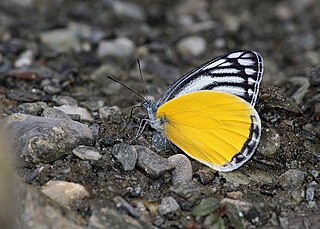
Delias agostina, the yellow Jezebel is a medium-sized butterfly of the family Pieridae, that is, the yellows and whites.
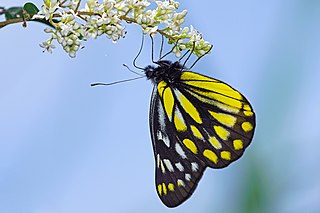
Delias berinda, the dark Jezebel is a medium-sized butterfly of the family Pieridae, that is, the yellows and whites. The species was first described by Frederic Moore in 1872.
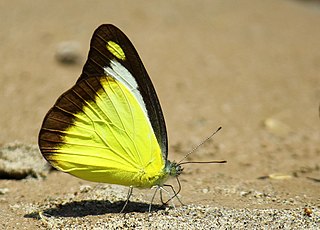
Appias lyncida, the chocolate albatross, is a butterfly of the family Pieridae, that is, the yellows and whites, which is found in south and southeast Asia.

Appias panda, the Nicobar albatross, is a small butterfly of the family Pieridae, that is, the yellows and whites, which is found in the Nicobar Islands of India.

Colias thrasibulus, the lemon clouded yellow, is a small butterfly of the family Pieridae, that is, the yellows and whites. It is found in India.

Colias ladakensis, the Ladakh clouded yellow, is a small butterfly of the family Pieridae, that is, the whites and yellows, that is found in India.

Colias eogene, the fiery clouded yellow, is a small butterfly of the family Pieridae, that is, the yellows and whites, which is found in India.

Colias stoliczkana, the orange clouded yellow, is a small butterfly of the family Pieridae, that is, the yellows and whites, that is found in India.

Colias dubia, the dwarf clouded yellow, is a small butterfly of the family Pieridae, that is, the yellows and whites, that is found in India.
Harish (Honnayya) S. Gaonkar is an Indian specialist on butterflies who contributed to the Zoological Museum at the University of Copenhagen, Denmark and wrote a 1996 compilation of butterflies of Western Ghats, South India cataloguing 330 species. Gaonkar earned his PhD from the University of California, Berkeley.
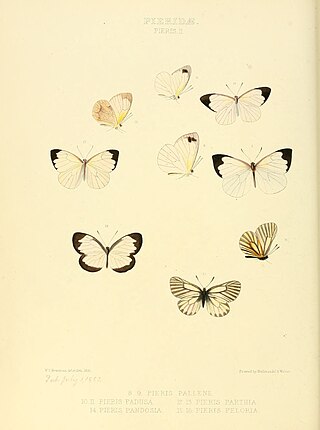
Mesapia is a genus of butterflies in the family Pieridae. It contains only one species, Mesapia peloria, the Tibet blackvein, which is found in India, Nepal and China. It is a mid-sized to large species.



















